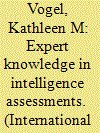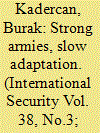|
|
|
Sort Order |
|
|
|
Items / Page
|
|
|
|
|
|
|
| Srl | Item |
| 1 |
ID:
127894


|
|
|
| 2 |
ID:
127889


|
|
|
|
|
| Publication |
2013.
|
| Summary/Abstract |
In 2011, scientists in the Netherlands and Japan announced that they had created a modified variant of the H5N1 avian influenza virus that was transmissible via aerosol, raising fears of a new, highly lethal H5N1 virus that could cause a deadly global pandemic. Soon, government officials and the media were raising alarms about the wisdom of publishing such experimental methods and results in the open scientific literature. Their concerns sparked a large public controversy about the H5N1 experiments and their potential publication. In the midst of this controversy, U.S. intelligence analysts began assessing the potential security implications of the H5N1 manuscripts, including whether a terrorist, criminal, or state could easily replicate these experiments and create mutated viruses for bioweapons use. An in-depth look at this controversy reveals that, first, U.S. intelligence analysts do not have adequate social and material resources to identify and evaluate the tacit knowledge, or know-how, that underpins dual-use experiments such as those in the H5N1 case. Second, they lack dedicated structures and methods to understand the politics that characterize the use of technical expertise in such controversial biosecurity issues. Third, they require new types, structures, and uses of expert knowledge to enable them to make more informed and balanced assessments of biosecurity threats.
|
|
|
|
|
|
|
|
|
|
|
|
|
|
|
|
| 3 |
ID:
127888


|
|
|
|
|
| Publication |
2013.
|
| Summary/Abstract |
In international relations, unlike the natural sciences, there are few fundamental principles or laws. The world map, however, reveals at least one iron law of global politics: human territoriality. Almost every inch of the globe is partitioned into exclusive and bounded spaces that "belong" to specific groups of humans. Any that is not-such as Kashmir, Jerusalem, and the South China Sea-remains hotly contested. Throughout history, territory has led to recurrent and severe conflict. States are prepared to go to war, and individuals are prepared to die, even over land with little intrinsic value. While such behavior presents a puzzle for international relations theory, a broader evolutionary perspective reveals that territorial behavior has the following three characteristics: (1) it is common across the animal kingdom, suggesting a convergent solution to a common strategic problem; (2) it is a dominant strategy in the "hawk-dove" game of evolutionary game theory (under certain well-defined conditions); and (3) it follows a strategic logic, but one calibrated to cost-benefit ratios that prevailed in our evolutionary past, not those of the present. These insights generate novel predictions about when territorial conflict is more or less likely to occur in international relations.
|
|
|
|
|
|
|
|
|
|
|
|
|
|
|
|
| 4 |
ID:
127893


|
|
|
|
|
| Publication |
2013.
|
| Summary/Abstract |
How should the United States respond to China's rise? What are China's longterm strategic goals? What are the implications of U.S.-China strategic interactions for world order? Three recent works-Aaron Friedberg's A Contest for Supremacy, Hugh White's The China Choice, and Yan Xuetong's Ancient Chinese Political Thought, Modern Chinese Power-grapple with these questions in authoritative and revealing ways. This review essay examines the answers provided by these authors, with the aim of clarifying the different underlying assumptions that led them to their conclusions. Four themes are found to be especially pertinent. These are the assumptions the authors hold about the existing distribution of power, China's strategic objectives, the role of economic interdependence in Asia, and the relationship between democracy and political legitimacy. The way the authors parse these themes-which ones they bracket or admit into their analysis, and how they weigh and combine them-helps to reveal the underlying bases of their and, by implication, our policy preferences. The essay concludes by suggesting that contrary to the view of some, time has something to offer both sides. And if those opportunities are properly understood by the United States and China, the prospects for peaceful competition and coevolution improve.
|
|
|
|
|
|
|
|
|
|
|
|
|
|
|
|
| 5 |
ID:
127895


|
|
|
| 6 |
ID:
127891


|
|
|
|
|
| Publication |
2013.
|
| Summary/Abstract |
Why are some states more willing to adopt military innovations than others? Why, for example, were the great powers of Europe able to successfully reform their military practices to better adapt to and participate in the so-called military revolution of the sixteenth and seventeenth centuries while their most important extra-European competitor, the Ottoman Empire, failed to do so? This puzzle is best explained by two factors: civil-military relations and historical timing. In the Ottoman Empire, the emergence of an institutionally strong and internally cohesive army during the early stages of state formation-in the late fourteenth century-equipped the military with substantial bargaining powers. In contrast, the great powers of Europe drew heavily on private providers of military power during the military revolution and developed similar armies only by the second half of the seventeenth century, limiting the bargaining leverage of European militaries over their rulers. In essence, the Ottoman standing army was able to block reform efforts that it believed challenged its parochial interests. Absent a similar institutional challenge, European rulers initiated military reforms and motivated officers and military entrepreneurs to participate in the ongoing military revolution.
|
|
|
|
|
|
|
|
|
|
|
|
|
|
|
|
| 7 |
ID:
127890


|
|
|
|
|
| Publication |
2013.
|
| Summary/Abstract |
When and why do national movements succeed? What explains variation in the use and effectiveness of political violence employed by nationalist groups? Groups pursue common strategic goals against external enemies, such as the founding of a new state, while engaging in zero-sum competition for organizational dominance with internal rivals in their national movement. The distribution of power within a national movement provides its structure, which serves as the key variable for both the internal and external struggle. The hierarchical position of groups within the movement drives their actions, while the number of significant groups in the movement drives its effectiveness. Contrary to existing scholarship that treats nonstate coercers as unitary or suggests that united or fragmented movements perform best, hegemonic movements with one significant group are most likely to succeed. Hegemonic movement structure incentivizes the pursuit of shared strategic goals; reduces counterproductive violent mechanisms and foreign meddling; and improves the movement's coherence in strategy, clarity in signaling, and credibility in threats and assurances to yield strategic success. Analysis of seventeen campaigns involving sixteen groups within the Palestinian and Algerian national movements reveals that the power distribution theory explains greater variation in the effectiveness of national movements than previous scholarship.
|
|
|
|
|
|
|
|
|
|
|
|
|
|
|
|
|
|
|
|
|